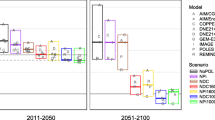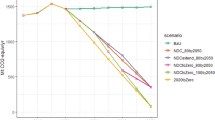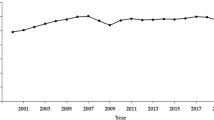Abstract
Toward the achievement of the 2 °C target, Japan has set several GHG mitigation targets after ratifying the Kyoto Protocol. In 2008, in order to discuss the GHG mitigation target in 2020 at COP15 held in Copenhagen, the committee on the mid- and long-term target in Japan was organized at the Cabinet Secretariat. At that discussion, the proposed six options were quantified, and finally, 15 % reduction in 2020 compared with 2005 level was selected as a target.
Because of the change of government, the new mitigation target in 2020, 25 % reduction compared to 1990, was announced at the United Nations Climate Change Summit in 2009. Then, the road maps to achieve this 25 % reduction target were quantified at the Central Environment Council. But just after they completed the road maps to achieve the target, the Great East Japan Earthquake and Fukushima Daiichi Nuclear Power Plant accident happened on March 11, 2011. Due to the nuclear power accident, the GHG mitigation road map and the future energy mix should be reconsidered. In 2012, the Energy and Environment Council forecasted that the GHG emissions in 2020 would be 5–9 % reduction compared to the 1990 level in the case of the prudent economic growth case.
After the change of government again, at the COP19 of UNFCCC in Warszawa in 2013, the new GHG mitigation target in 2020 was announced to be 3.8 % reduction compared to the 2005 level under the assumption of the no nuclear power supply. And in 2015, the mitigation target in 2030 was proposed to 1.042 GtCO2, that is, 26.0 % reduction compared to the 2013 level.
On the other hand, in the 4th Environmental Basic Plan endorsed by the Cabinet in 2012, the 80 % reduction of the GHG emissions was written clearly. In this paper, in order to assess the feasibility of this 2050 target, we utilized the AIM/Enduse to disaggregate Japan into 10 regions. The treated technologies include renewable energy technologies, carbon capture and storage (CCS), and energy-saving technologies. The study shows that it is feasible to achieve 80 % emission reduction in Japan even without nuclear power. The impact of nuclear phaseout as compared to the illustrative scenario is relatively small in the long term because of the small share of nuclear energy in 2050 in any case. Achieving long-term emission reduction target proves to be still feasible with substantial increase of renewable energy, particularly solar PV and wind power. The share of renewable energy in electricity supply reaches approximately 85 % in 2050, and variable renewable energies account for about 63 % in electricity generation in 2050, hence imposing a further challenge for integration into the electricity system.
The feature of mitigation target in Japan is mainly based on the bottom-up approach. That is to say, the process stressed the feasibility of the target. On the other hand, the top-down decision is also requested for the ambitious reduction target. Toward the achievement of 2 °C target, taking actions with the long-term perspective becomes more important.
You have full access to this open access chapter, Download chapter PDF
Similar content being viewed by others
Keywords
- Mitigation
- Carbon dioxide
- 2 °C target
- Energy mix
- Electricity
- Enduse model
- Japan
- Nuclear power
- Carbon capture and storage
-
Japan’s mitigation target in 2050 is set to be by 80 % reduction by the 4th Environmental Basic Plan.
-
The existing target is set based on the available technologies, that is to say, the bottom-up approach.
-
Top-down decision is also requested for the ambitious reduction target.
-
The options to achieve the ambitious target have been available.
1 Introduction
In 2013 and 2014, the IPCC 5th Assessment Reports were approved. In this report, it is concluded that “It is extremely likely that human influence has been the dominant cause of observed warming since the mid-20th century” (IPCC 2013). The IPCC 5th Assessment Report mentions that, in order to achieve the 2 °C target, which is to limit the increase in global mean surface temperature to less than 2 °C, the GHG emissions in 2050 and 2100 will have to be reduced by 41–72 % and 78–118 %, respectively, compared with the 2010 level (IPCC 2014). Figure 4.1 shows the future GHG emissions, and the right blue range (430–480 ppmCO2eq) is the emission pathways to achieve the 2 °C target likely.
Toward the achievement of the 2 °C target, Japan has set several GHG mitigation targets after ratifying the Kyoto Protocol. In the following sections, mitigation target will be discussed and the quantification figures using the AIM (Asia-Pacific Integrated Model) are explained.
2 From the Kyoto Protocol to Middle-Term Target
Figure 4.2 shows the trend of GHG emissions in Japan from 1990 to 2013. The actual GHG emissions during the 1st commitment period in Japan exceeded the emission target set by the Kyoto Protocol, but if the effects of carbon sink and Kyoto Mechanism such as mitigation outside of Japan are taken into account, the emissions in Japan could achieve the emission target. On the other hand, the trend of GHG emission after 2010 would increase because of the Great East Japan Earthquake and Fukushima Daiichi Nuclear Power Plant accident in March 2011. Figure 4.3 shows the sectoral GHG emissions in Japan. Among the sectors, the emissions from commercial and residential sectors increased after the nuclear power plant accident.
Sectoral GHG emissions in Japan (Data source: GIO 2015)
In 2015, the COP21 of UNFCCC will be held in Paris. At this meeting, the post-2020 target will be discussed. Prior to the COP21, INDCs (Intended Nationally Determined Contributions), that is to say, the new ambitious target of GHG emission reduction, will be announced by each country by March 2015. Japan has been discussing this issue under the joint committee between the Ministry of the Environment and Ministry of Economy, Trade and Industry. On April 30, the new GHG mitigation target in 2030 was announced by the government. The value is 1.042 GtCO2eq, and this is 26.0 % reduction from the 2013 level. If the base year is set to 2005, the value of the reduction target becomes 25.4 %. The outline of the mitigation target in Japan in 2030 is introduced in Table 4.1.
The GHG mitigation targets in Japan have been changed when the government was changed. In 2008, in order to discuss the GHG mitigation target in 2020 at COP15 held in Copenhagen, the committee on the mid- and long-term target in Japan was organized at the Cabinet Secretariat. At that discussion, three types of models were utilized, global enduse model, Japan enduse model, and Japan economic model, and the proposed six options were quantified. Finally, 15 % reduction in 2020 compared with the 2005 level was selected as a target by former Prime Minister Mr. T. Aso. Figure 4.4 represents the contents of six options.
After the change of the government, the new Prime Minister, Mr. Y. Hatoyama, announced the 25 % reduction compared to 1990 at the United Nations Climate Change Summit held in New York in 2009. In reaction to this new mitigation target, the road maps to achieve this 25 % reduction target were quantified at the Central Environment Council. But just after they completed the road maps to achieve the target, the Great East Japan Earthquake and the accident of Fukushima Daiichi Nuclear Power Plant of Tokyo Electric Power Company (TEPCO) happened on March 11, 2011. Due to the nuclear power accident, the GHG mitigation road map and the future energy mix should be reconsidered, because those at that time relied on nuclear power. In 2012, the Energy and Environment Council forecasted that the GHG emissions in 2020 would be 5–9 % reduction compared to 1990 level in the case of the prudent economic growth case.
After the next change of the government, the new GHG mitigation target was officially revised to be 3.8 % reduction compared to the 2005 level under the assumption of the no nuclear power at the COP19 of UNFCCC in Warszawa in 2013. But this target is equivalent to +3.1 % to the 1990 level. At that time, assessment using models was not implemented. Figure 4.5 shows the GHG emission forecasts in 2020 for the high economic growth case by using the AIM/Enduse [Japan] model executed in 2012. In this figure, the target of 2013 is represented by the red line. And Fig. 4.6 shows the relationship between the additional investment cost and saved energy costs. From this figure, the total saved energy costs for the lifetime of each equipment can exceed the total additional investment costs to install the energy-saving equipment. That is to say, if we have long-term perspectives, the energy-saving investment will bring the benefit to the economy in Japan. But in the actual world, the investment is decided from the short-term scope, and then, the introduction of the energy-saving technologies is difficult.
Table 4.2 summarizes the brief history of decision of GHG emission mitigation in Japan and the world.
3 2 °C Target and Mitigation in Japan in 2050
As shown in Fig. 4.1 from IPCC (2014), in order to achieve the 2 °C target, the global GHG emissions in 2050 would be 41–72 % compared to the 2010 level. Since the G8 Summit at Heiligendamm in 2007, the global leaders have shared the long-term vision that the GHG emissions in 2050 should be half compared to the present level. If GHG emission per capita is equal among the world in 2050, it becomes around 2 tCO2. In the case of Japan, the present emission level is around 10 tCO2. That is to say, the GHG emissions per capita should be 80 % reduction to achieve the 2 °C target.
In the 4th Environmental Basic Plan endorsed by the Cabinet in 2012, the long-term GHG emission mitigation target was made clear. The target in 2050 is 80 % reduction of GHG emissions. In the following sections, the possibility of 80 % reduction of GHG emissions is examined. The quantitative results are based on Kainuma et al. (2014) for the report of the Deep Decarbonization Pathways Project (DDPP). DDPP is organized by the Sustainable Development Solutions Network (SDSN) and the Institute for Sustainable Development and International Relations (IDDRI), and 15 countries including Japan and international organizations join this project. The interim report was opened at the Climate Summit in 2014. For more information, please see IDDRI and SDSN (2014).
4 How to Achieve 80 % Reduction Target in Japan
As shown in the explanation of the 4th Environmental Basic Plan, the mitigation target in 2050 is set to be 80 % reduction. In order to assess the 2050 target, we utilized the AIM/Enduse to disaggregate Japan into 10 regions. The treated technologies are the same as the analyses for 2020 and 2030 using the national model, and the treatment of future is also the same, that is to say, recursive dynamics. On the other hand, the features of this model are that the local renewable energy potential can be reflected, interconnected line of electricity among the regions can be assessed, and so on.
Other important assumptions are nuclear power and carbon capture and storage (CCS). As regards the nuclear power, the following are the main assumptions:
-
Lifetime is limited to 40 years for plants built in 1990 and 50 years for all other plants, and from 2013 to 2035, an additional three GW nuclear plants capacity is included based on the premises of New Policies Scenario of the World Energy Outlook 2013 (IEA 2013).
-
Subject to these assumptions and maximum capacity factor of 70 % for all plants, electricity generation from nuclear plants represents about 50 TWh in 2050.
As for the CCS, the following assumptions are set:
-
Geologic carbon storage potential.
-
Complying with previous studies, CCS technologies are assumed to be available in 2025, and annual CO2 storage volume is assumed to increase up to 200 MtCO2/year in 2050.
In the illustrative scenario, the primary energy supply and demand in 2050 decreases to almost half compared to the 2010 level as shown in Fig. 4.7. In 2050, renewables and fossil fuels with CCS account for more than 50 % of primary energy supply. In the power sector, the nuclear power is assumed to be phased out gradually, and electricity generation from coal without CCS is entirely phased out by 2050. Renewable energy is developed over the mid- to long terms and reaches approximately 59 % of total electricity generation through large-scale deployments of solar PV and wind power. In addition, natural gas (equipped with CCS) is developed to ensure balancing of the network and reaches about a third of total electricity generation in 2050. Carbon intensity of electricity falls to nearly zero in 2050 as shown in Fig. 4.8. And also, in the final energy demand sector, the energy intensity will be improved, and electricity will be the dominant energy over the long term. As a result, the long-term GHG emission reduction target in 2050 will be reached as shown in Fig. 4.9.
The alternative pathways are also investigated using the same model. In the “without nuclear power scenario,” an 80 % emission reduction in 2050 is still feasible. However, higher carbon intensity is experienced during the transition period. The impact of nuclear phaseout as compared to the illustrative scenario is relatively small in the long term, given the small share of nuclear energy in 2050 in any case. Another alternative scenario is “less CCS scenario,” in which CO2 storage volume is assumed to be limited to 100 MtCO2/year. Achieving long-term emission reduction target proves to be still feasible with substantial increase of renewable energy, particularly solar PV and wind power. The share of renewable energy in electricity supply reaches approximately 85 % in 2050, and variable renewable energies account for about 63 % in electricity generation in 2050, hence imposing a further challenge for integration into the electricity system.
5 Conclusion
In this chapter, the historical change of the emission reduction target in Japan and the possibility of 80 % reduction in 2050 in Japan are represented. The feature of mitigation target in Japan is mainly based on the bottom-up approach. That is to say, the process stressed the feasibility of the target. On the other hand, the top-down decision is also requested for the ambitious reduction target.
From the previous estimations, even in Japan, there are still many reduction potentials. Toward the achievement of 2 °C target, taking actions with the long-term perspective becomes more important.
References
GIO (2014) Japan’s national greenhouse gas emissions in fiscal year 2012 (Final figures). http://www.nies.go.jp/whatsnew/2014/20140415/20140415001-e.pdf
GIO (2015) Japan’s national greenhouse gas emissions in fiscal year 2013 (Final figures). http://www.nies.go.jp/whatsnew/2015/gaiyo-e.pdf
IDDRI and SDSN (2014) Pathways to deep decarbonization, 2014 report. http://unsdsn.org/wp-content/uploads/2014/09/DDPP_Digit_updated.pdf
IEA (2013) World energy outlook 2013. OECD/IEA, Paris
IPCC (2013) Climate change 2014: The physical science basis. Cambridge University Press, Cambridge and New York
IPCC (2014) Climate change 2014: mitigation. Cambridge University Press, Cambridge and New York
Kainuma M, Oshiro K, Hibino G, Masui T (2014) Japan chapter of pathways to deep decarbonization, 2014 report. http://unsdsn.org/wp-content/uploads/2014/09/DDPP_2014_report_Japan_chapter.pdf
Acknowledgment
The research in this chapter is supported by the Environment Research and Technology Development Fund by the Ministry of the Environment, Japan (2-1402).
Author information
Authors and Affiliations
Corresponding author
Editor information
Editors and Affiliations
Rights and permissions
Open Access This chapter is distributed under the terms of the Creative Commons Attribution Noncommercial License, which permits any noncommercial use, distribution, and reproduction in any medium, provided the original author(s) and source are credited.
Copyright information
© 2016 The Author(s)
About this chapter
Cite this chapter
Masui, T., Oshiro, K., Kainuma, M. (2016). Eighty Percent Reduction Scenario in Japan. In: Nishioka, S. (eds) Enabling Asia to Stabilise the Climate. Springer, Singapore. https://doi.org/10.1007/978-981-287-826-7_4
Download citation
DOI: https://doi.org/10.1007/978-981-287-826-7_4
Published:
Publisher Name: Springer, Singapore
Print ISBN: 978-981-287-825-0
Online ISBN: 978-981-287-826-7
eBook Packages: Earth and Environmental ScienceEarth and Environmental Science (R0)













